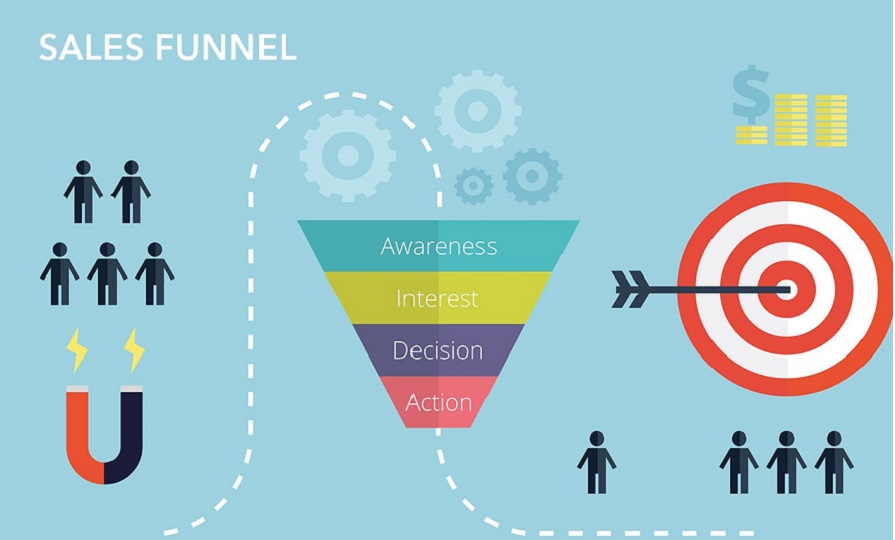A sales funnel has a significant impact on consumers’ behavior. Therefore, one of the most significant business concepts is designing and managing your sales funnel. In this article, you will learn what the sales funnel is, the different stages of the sales funnel, and how to build one for your business.
Let’s begin.
What is a sales funnel?
A sales funnel a marketing strategy designed to understand each step a prospect or person takes to become a customer.
For example, if a group of people walks by your shop, just a few people stop by to check what you have in store; that’s the following sales funnel. Then a prospect noticed some nice shoes and decided to check them out; that’s the next step of the funnel.
Then this customer picks about two different shoes and proceeds to check out and pay; that’s the last stage of the funnel.
The stages of the sales funnel work for all kinds of businesses. For example, it could be through email, sales team, store, website, online page, consultation, etc.
Also Read: How To Promote Your Small Business Using Online Webinar
The four stages of a sales funnel
Many terms are used to describe the different stages of a sales funnel, and in this article, the four most common steps will be discussed here. You can use AIDA’s acronym to remember the four sales funnel stages: awareness, interest, decision, and action.
Each of these stages requires a different approach from you because you wouldn’t like to send the wrong message at the wrong time
1. Awareness
This is the stage when you capture a prospect’s attention for the first time. It could be through Facebook, Instagram, Google search, Whatsapp, billboards, or some other channel. Here, the prospect becomes aware of your business and its offers.
Sometimes, the prospects may buy immediately, while in most cases, they do not buy but will return to your website to engage with your business.
2. Interest
At the interest stage in a sales funnel, a consumer is actively searching for information that will help them solve a need, compare, and weigh some options. The quality of the content that the prospect consumes on your website will allow them to make an informed decision about your business.
3. Decision
The prospect has decided and is ready to buy at this stage. He must have considered many other options and has settled for a few or one.
When your business strategy comes in, you must make your best offer, which could be paid on delivery, free shipping, 20% discount for first-time customers, buy two get one free, webinar, sales page, etc. It has to be something that they can not afford to miss.
4. Action
Action is the last stage of a sales funnel. In this case, the customer has finally bought your products! Although you sure do not want the customer to stop at one purchase, you would like the customer to return for more purchases.
Therefore, your primary focus should be to retain the customer. Appreciate every customer no matter the number of products that they buy, ask for their feedback, make them write reviews, and ask for referrals. One happy customer can bring in two or more customers for you.
How sales funnel works
This explains how a consumer started by being a visitor, prospect to a lead, and then a customer. A visitor was at your website through a referral, social link, or Google search. Already at this point, he is a prospect.
The prospect then goes ahead to check your products, services, and blog post, and while the prospect is on this, you offer them an opportunity to sign up for your webinar or email list.
If peradventure, the prospect successfully signs up, they automatically become a lead. By generating leads from prospects, you target them outside your website and market to them. There is an excellent possibility that the prospects will return to your website if you offer good deals or propelling messages.
Nevertheless, you can influence a prospect’s journey, but you will need to fully understand your marketing funnel so that optimization will be easy for you.
Importance of a sales funnel
1. Your sales funnel very important because it helps you to understand a customer journey. When a prospect visits but does not make any purchase, you can revisit your sales funnel to find out what stage the customer drops and why the customer never bought from your brand.
2. The sales funnel gives you a valuable framework through which you can analyze your business and identify areas for improvement.
3. It can help your business to grow and generate more sales if you master the art of the sales funnel very well. The essence is to turn prospects into customers and customers into returning customers.
Also Read: Small Business Tips: How to deal with difficult customers in Business
Conclusion
As you begin to study your customer’s journey, you will notice that you have more people at the top of the sales funnel than you will eventually have at the bottom of the funnel. This is because creating a sales channel requires hard work and dedication. So, if you want to stay ahead of your competitors, you must learn how to design and optimize your sales funnel.
Author Bio
Uju is a well-seasoned SEO content writer for tech and SaaS brands. You can reach out to me on LinkedIn and Twitter

